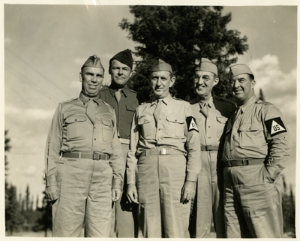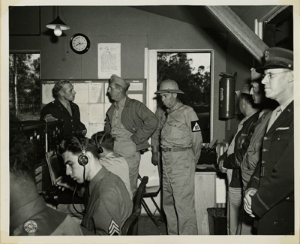
On July 25, 1943, shortly after Allied forces invaded Sicily and Allied bombers targeted Rome, five United States senators set out on a unique and controversial journey: to inspect American military installations engaged across the globe in the Second World War. They boarded a converted bomber named the “Guess Where II” at Washington National Airport (now Ronald Reagan Washington National Airport) to begin a 65-day tour of U.S. military installations around the world. Each senator wore a dog tag and carried one knife, one steel helmet, extra cigarettes, emergency food rations, manuals on jungle survival, and two military uniforms. The senators were to wear the military uniforms while flying over enemy territory and visiting U.S. field operations in the hope that, if captured, they would be treated humanely as prisoners of war.1

The idea for this inspection tour originated among members of the Senate Committee on Military Affairs and the Senate Special Committee to Investigate the National Defense Program, also known as the Truman Committee. The Military Affairs Committee had been examining every aspect of war mobilization, from soldier recruitment to weapons and supply contracts. The Truman Committee, chaired by Missouri senator Harry Truman, had spent two years exposing waste and corruption in the awarding of defense contracts, including in the construction of military facilities around the United States. Both committees wished to expand their investigations to include inspections of facilities overseas and initially quarreled over which panel would take on the task. The Truman Committee received approval for a tour from General George C. Marshall and President Franklin D. Roosevelt in early 1943. Albert “Happy” Chandler of Kentucky, who chaired a Military Affairs subcommittee also planning overseas inspections, protested and stated that he already had “an understanding” with the War Department about a tour of military bases. Chandler took his case to General Marshall and petulantly told reporters that “maybe the Army ought to take up its legislation with the Truman Committee.”2

The army did not want the “embarrassment” of choosing between the two committees, so the White House tasked Majority Leader Alben Barkley and Republican Leader Charles McNary with reaching a compromise. In July Barkley, who initially opposed the idea of any senators traveling abroad and taking up the time of military commanders, announced the creation of a small, bipartisan ad hoc committee of five senators to take the trip, chaired by Georgia Democrat Richard Russell and composed of two members from the Truman Committee and two from Military Affairs—Ralph O. Brewster of Maine, Happy Chandler of Kentucky, James Mead of New York, and Henry Cabot Lodge, Jr., of Massachusetts.3
The committee's goals were to observe the condition and morale of American troops, the quality and effectiveness of war materiel under combat conditions, and the operations of distributing military and civilian supplies to the Allied front lines. The investigatory committee believed, as Russell later explained, that what they learned on the trip would be helpful “in dealing with questions arising from our relations with the other Allied powers, and in preparing for the many trying and complex issues whose solution must have final approval by the Senate after the war is over.” In particular, the committee was concerned about securing access rights at the war’s conclusion to military installations that the U.S. had helped to establish overseas.4

As laudable as this mission seemed, departing members received a good deal of criticism both from colleagues and constituents. At a time of stringent gasoline rationing, a constituent wrote Russell that it would be wiser to allocate his aircraft's fuel to the needs of “your Georgia people.” Senator Bennett Clark of Missouri suggested that military commanders would not “let them see enough to stick in their eye.” The senators were determined to prove Clark wrong.5
The senators' first stop was England, where they bunked with the Eighth Air Force, dined with the king and queen, and interviewed Prime Minister Winston Churchill. They moved on to North Africa, spending a week in various cities along the Mediterranean Sea. From there they toured installations in the Persian Gulf, where U.S. supplies were being shipped to support the Soviet Union. They continued on to India, China, Australia, and Hawaii before returning home on September 28. The flight from the British colony of Ceylon (present day Sri Lanka) to the west coast of Australia, 3,200 miles over water, was the first time anyone had flown nonstop over the vast Indian Ocean in a land-based plane. Along the way the senators met with commanders and high-ranking civilian officials as well as enlisted men and wounded soldiers. In total the trip took 65 days and logged 40,000 miles.6
Upon their return, Russell had planned to brief the Senate at a secret session set for October 7. Before that briefing, however, Military Affairs Committee member Henry Cabot Lodge, Jr., upstaged Russell by giving his own account in public session, a move that angered the chairman. Russell shared the committee’s report with his colleagues as planned and the next day had summary findings inserted into the Congressional Record for public consumption. The report framed the key issues of postwar reconstruction and policy, including recommendations for continued U.S. access to overseas military bases, the prospects of continued foreign aid after the fighting stopped, and a proposal for merging American military branches into a single department after the war.7

The report set a firm precedent for future overseas travel by senators, with additional trips taking place in 1945. Senator James M. Tunnell led a subcommittee of the Committee to Investigate the National Defense Program, known as the Mead Committee after the departure of Harry Truman, on another visit to military installations in North Africa and the Middle East in early 1945. In May 1945, after Germany had surrendered, Russell guided a group of eight senators from the Military Affairs and Naval Affairs committees on a trip to France and Germany, where some of the hardest fighting of the war had taken place.8
While some observers had doubted the utility of the 1943 tour, the detailed report of Russell’s committee persuaded them that the senators had completed a useful task, setting the stage for future congressional delegations (CODELs). New York Times columnist Arthur Krock, who admitted that he had his reservations about the trip, afterwards praised the group for its careful examinations and declared the trip “an excellent illustration of what can be done by Congress by the use of the effective and responsible committee system.”9
Notes
4. Katherine Scott, “A Safety Valve: The Truman Committee’s Oversight during World War II,” in Colton C. Campbell and David P. Auerswald, eds., Congress and Civil Military Relations (Washington, D.C.: Georgetown University Press, 2015), 36–52; Congressional Record, 78th Cong., 1st sess., October 28, 1943, 8860; “Senators Seek Post-War Base Showdown Now,” Chicago Daily Tribune, July 04, 1943, 8.